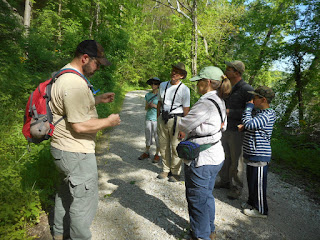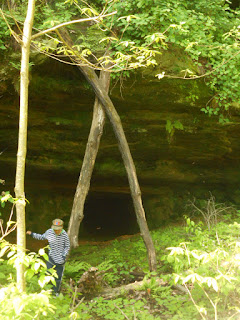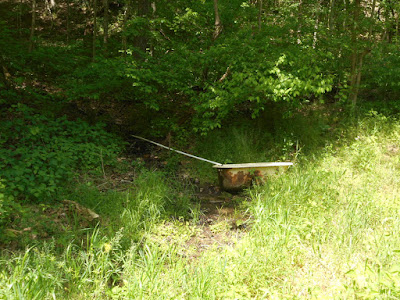The Bluffs of Beaver Bend Nature
Preserve
near Shoals, Indiana
May 7, 2016
Indiana is full of unique, beautiful
nature preserves, owned by the state, The Nature Conservancy, and
various land trusts. On May 7, 2016, a friend and I traveled to one
that is considered “one of the crown jewels” of the state's
nature preserves, owned and managed by the Indiana Department of
Natural Resources Division of Nature Preserves in partnership with
The Nature Conservancy of Indiana and the Indiana Heritage Trust.. We
were going on a walk led by Ryan Keller of the IN – DNR. Neither of
us had been there before, and we were about to be awed.
Hugging and overlooking a bend in the
East Fork of the White River for about a mile, at its confluence with
Beaver Creek, Bluffs of Beaver Bend is a 748-acre site in Martin
County. As part of the Shawnee Hills Natural Region, it is in a
rugged, rather unspoiled area. Within that region, as part of the
Crawford Upland, it is in the unglaciated hill country of southern
Indiana.
Magnificent, sheer bluffs tower 150
feet high, comprised of Mansfield Sandstone formed about 300 million
years ago. The scene is lovely with its bands of color as well as
varied texture. There are many holes and crevices, some large enough
to resemble caves. Due to rumors of gold years ago, one wishful
prospector enlarged a crevice to form a cave. Native Americans used
the crevices for shelter.
These surfaces also support a rare
bluff community of plant life, from the mosses, liverworts and
lichens to many ferns, flowering plants, nineteen kinds of shrubs and
thirty-eight species of trees.
Ferns, mosses, Wild Stonecrop and other plants on a cliff side
Wild Stonecrop (Sedum ternatum) in bloom on cliff side
Smooth Rock Cress, (Arabis laevigata) with long seed pods, among mosses on cliff rock
A rich community of ferns on a cliff face
Lady Fern
(Athyrium filix-femina)
(Athyrium filix-femina)
Sori on the back of Lady Fern leaves (I think they look like very tiny green caterpillars all curled up)
Christmas Fern (Polystichum acrostichoides) - fertile frond sections at the ends of upward-pointing fronds, sterile fronds below - this fern is evergreen
Walking fern (Asplenium rhizophyllum), one of the most unusual ferns in Indiana - tips of leaves grow very long and thin, starting new plants wherever they land across the rock face
The lovely Maidenhair Fern (Adiantum pedatum), among some Mayapple plants (Podophyllum peltatum)
Some unopened, bell-like blooms of Smooth Solomon's Seal (Polygonatum beflorum) hanging from the gracefully bent stem
At the base of the cliffs were the largest Smooth Solomon's Seal plants I had ever seen. Ryan said maybe it's because they are fed from the water trickling down the cliffs. Behind them is some Appendaged Waterleaf (Hydrophyllum appendiculatum) with its lavender blooms.
Solomon's Plume/Starry Solomon's Seal (Smilacina racemosa) was also blooming. The main difference between it and Smooth Solomon's Seal is the cluster of star-shaped flowers at the end of the stem.
Possibly Perforated Bellwort (Uvularia perfoliata), an endangered plant. This one needs to be verified. (Note: this was later determined to be Uvularia grandiflora, or Large-Flowered Bellwort, because there are hairs on the lower surface of the leaves.)
Common Alumroot (Heuchera americana) in bloom among ferns and Virginia Creeper (Parthenocissus quinquefolia)
A small batch of Lizard's Tail, pre-bloom (Saururus cernuus) growing in a spot where water tends to collect
Purple Rocket (Iodanthus pinnatifidus)
One of the shrub species at the bluffs, Bladdernut (Staphylea trifolia), with seed pods
Because Bluffs of Beaver Bend extends
from the river bank to dry cliff tops, it contains moist to dry-moist
forest communities. A diverse variety of animal wildlife calls this
place home or comes through during migration or hunting trips.
The White River - East Fork - with river bank flora
Eastern Tent Caterpillar (Malacosoma americanum) - unlike the Webworm caterpillars, these live in webs in the crooks of tree branches, not at the ends of branches. They venture out during the day to dine and then return to the safety of the communal web to digest.
Pearl Crescent (Phyciodes tharos tharos), a very common butterfly in Indiana. This one is possibly a male, and is possibly changing from the spring (marcia) to the summer (morpheus) phase. It is gathering nectar from a Fleabane.
"A Robin in her nest has very little time to rest ..."
The White River itself is home to some
rare species of fish and, historically, a rich population of mussels.
Tall mussel shell piles (middens) have been found, as the meat was
used by Native Americans for food and, later, the shells for the then
lucrative button industry.
Wild Yam (Dioscorea villosa)- some was vining up and down the cliffs
Ryan showing a plant that looks similar to the Wild Yam, but I think it's something different - maybe Wild Sweet-Potato (in a different family.) This has thinner, rounder leaves with shallow, red veining. A pretty plant - I need to explore this one some more.
We joined a small group of walkers and
our able and knowledgeable leader, Ryan, to take in this place, learn
about it and discover. We used the gravel road that runs between the
White River and the bluffs. This enabled us to experience the variety
of ecological communities.
Ryan showing us a Sedge (possibly Gray's Sedge - Carex grayi) and how to distinguish it from rushes and grasses (sedges have triangular stems)
Aphids on the stem of a Butterweed plant (Packera glabella)
An insect in the Order Diptera (the flies) on a Jewelweed leaf (genus Impatiens)
Cream Violets (Viola striata0
Wild Geranium
(Geranium maculatum)
(Geranium maculatum)
One of the Beardtongue species (genus Penstemon)
There is controversy over this plant, as to whether it is Hispid (Ranunculus hispidus) or Swamp Buttercup (R. septentrionalis), or if both of those are really the same species. I like the waxy looking flowers. (Note: it was later determined that this is probably Swamp Buttercup because it lacked the long runners of Hispid.)
Cleft Blue Phlox
(Phlox divaricata)
These show in various shades of pinks and blues and usually have rounded petal tips, but sometimes, like this one, the tips are notched
(Phlox divaricata)
These show in various shades of pinks and blues and usually have rounded petal tips, but sometimes, like this one, the tips are notched
The strong but elegant Wild Garlic (Allium canadense) about to bloom
Tall Meadowrue (Thalictrum pubescens), not yet in bloom
A late bloom of False Rue-Anemone (Enemion biternatum), which is normally an early spring bloomer
Violet Wood Sorrel
(Oxalis violacea)
(Oxalis violacea)
Philadelphia Fleabane (Erigeron philadelphicus) - the pinkest one I've ever seen (they tend to be white to pale pink)
I strongly urge all of you readers to
make a visit to Bluffs of Beaver Bend at any time of the year. I hear
that the winter landscape on the cliffs is quite a sight to behold. I
plan on going back again sometime.
Some signs of human habitation:
A log cabin with no running water, so ....
... there is a water-collecting system at the spring down the hill.
An old concrete silo that looks like a castle tower ...
... and another concrete silo with its accompanying barn in the distance.
For more information, check these books
and web sites:
A Guide to Natural Areas of Southern
Indiana: 119 Unique Places to Explore; Steven Higgs; Indiana
University Press; 2016.
The Nature Conservancy's Guide to
Indiana Preserves; Indiana University Press/Quarry Books; 2006.
From the Indiana Department of Natural Resources - includes a map and access directions
Photos of Bluffs of Beaver Bend by
Steven Higgs
From The Nature Conservancy


























































